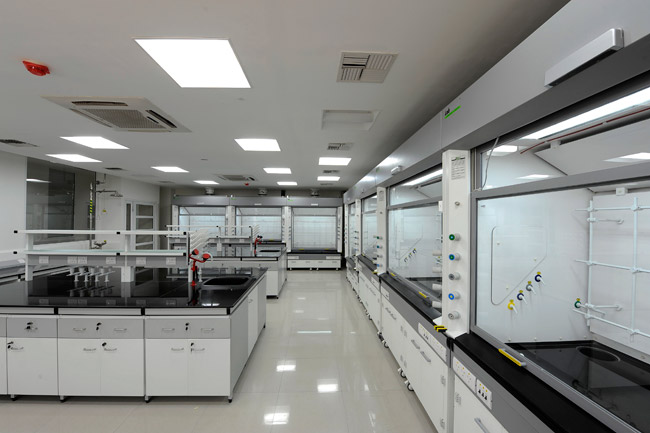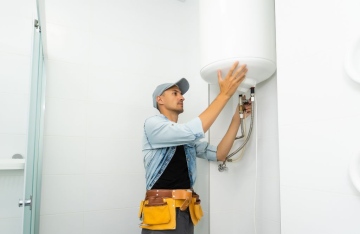Laboratory air flow control systems need to be designed with an eye toward both performance and economy. It’s possible to design a system that adequately serves the needs of the users of the laboratory, but consumes so much energy that it’s too expensive to run. Designs that focus too heavily on saving energy can have the opposite effect, and they can require substantial retrofits when the air quality fails to meet specifications over time. The opportunities for operational savings on laboratory air flow control systems require approaches that take a holistic approach to the problem of high performance and affordability. VAV systems are just such an approach.
VAV stands for Variable Air Volume. It means that instead of simple on/off operation of the air flow control systems, the airflows are balanced constantly. This dynamic, real-time approach saves money while simultaneously improving performance. Conventional air flow systems are balanced on paper during the design phase, and then balanced for real during construction and fit out of the laboratory or clean room by the HVAC installer.
A VAV system is balanced for a standard loading of the room, but the system is also capable of ramping the volume of air entering and leaving the enclosed room up or down as the required load increases or decreases. While they are more demanding to detail during the planning and installation phase, laboratory air flow control system experts like Phoenix Controls recommend VAV systems to laboratories who need the best performance with the most efficient energy use possible.

Great for Adapting to Changing Uses of the Room
Depending on the part of the country you’re in, or the particular sector that you’re referring to, VAV systems can be called by other names like Critical Airflow Controls or other similar terms. The purpose of the system is the same no matter what it’s called, however. VAV laboratory air flow control systems can greatly reduce energy costs over the useful life of the laboratory, which can sometimes be the single largest operating cost of a clean room environment. If detailed properly, it can also reduce capital costs as well.
A VAV system is especially valuable for environments subject to alteration over the years. If different equipment is introduced to the laboratory, and more personnel are added, the original balanced design will no longer be effective, and the clean room air systems will have to be redesigned from scratch. VAV systems are designed for more flexibility, and can be detailed to accommodate additional loads on the fly, as well as offering an opportunity to ramp down if the needs of the laboratory diminish over time. Either way, you use only the energy necessary to keep the clean room at exactly the right level of air circulation.
The 2 Types of VAV Laboratory Air Flow Control Systems
Because VAV systems can be infinitely variable, you could say that there are an infinite number of ways to set them up, but in practice, there are really only two types.
Full VAV
Full VAV systems automatically adjust themselves to the conditions in the room in real time, and these adjustments cover the full range of operating possibilites. This is the most demanding form of the laboratory air flow control systems available on the market today, but the savings in energy use over time make them well worth the effort. One of the overlooked benefits of full VAV is that it’s as easy to operate as a constant volume system. Both systems are designed for set and forget operation. The only difference between their operations for people inside the clean room environment is that the constant volume system can’t be adjusted, and the VAV doesn’t need to be adjusted because it automatically adjusts itself.
VAV is hardly the most popular form of air flow control systems currently in use. Legacy systems really didn’t have the technology available to make a truly automated system. No matter how much money a VAV system costs, it does add expense and complexity to construction. If number crunchers can’t effectively amortize the additional upfront costs because they don’t expect to be operating the laboratory for long enough, they might opt for a constant volume system, or a two-level air system.
The Two-Level System
HVAC engineers came up with a two-position system to split the difference between full VAV implementation and a constant value system. In short, it’s simply a system that is rigged to run at either a high or low setting. While the two-level laboratory air flow control systems can be switched from low to high and back using an automated system similar to a VAV setup, in practice the decision is usually left up to the occupants. A simple high/low switch is placed within easy reach in the clean room and workers can adjust it as necessary.
Because the air within a laboratory or clean room setting is so heavily treated, it’s usually easy for occupants to sense when the HVAC system is being overmatched by conditions in the room. For instance, it’s very unusual to encounter a strong odor of any kind in a clean room environment, so it acts as an instant alert. If the temperature in the room rises, or it becomes stuffy, it will also be evident to workers in the room.
VAV Uses Mature Technology
VAV Laboratory Air Flow Control Systems have been in use for almost two decades now, and are no longer seen as exceptional in any laboratory construction project. Two factors are making VAV implementation almost mandatory in new projects. In a production atmosphere, today’s productivity rates mean that any downtime in a project due to contamination costs a great deal more than in past. Designers are tasked with identifying potential problems before they happen and making sure the equipment and protocols are in place to minimize risk. This also applies to worker exposure to unpleasant and dangerous substances in laboratory settings.
The second appeal of VAV design is the enormous amount of energy that it takes to run a clean room using a constant volume system. In the past, inexpensive energy made running costs a secondary consideration, but that has changed dramatically. The factors that have driven cost containment and quality in clean room design will likely make VAV Laboratory Air Flow Control Systems almost universal in the years to come.




